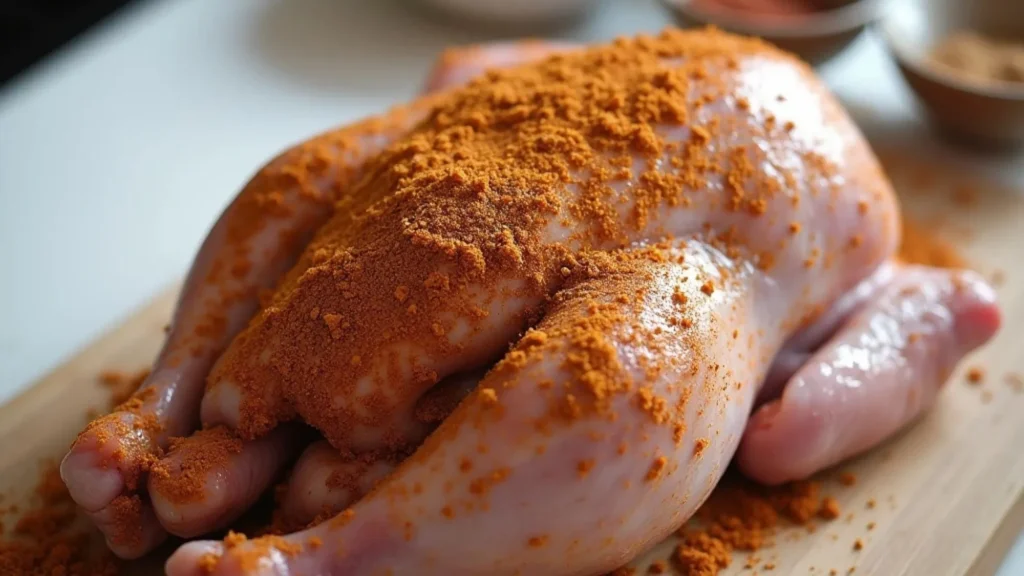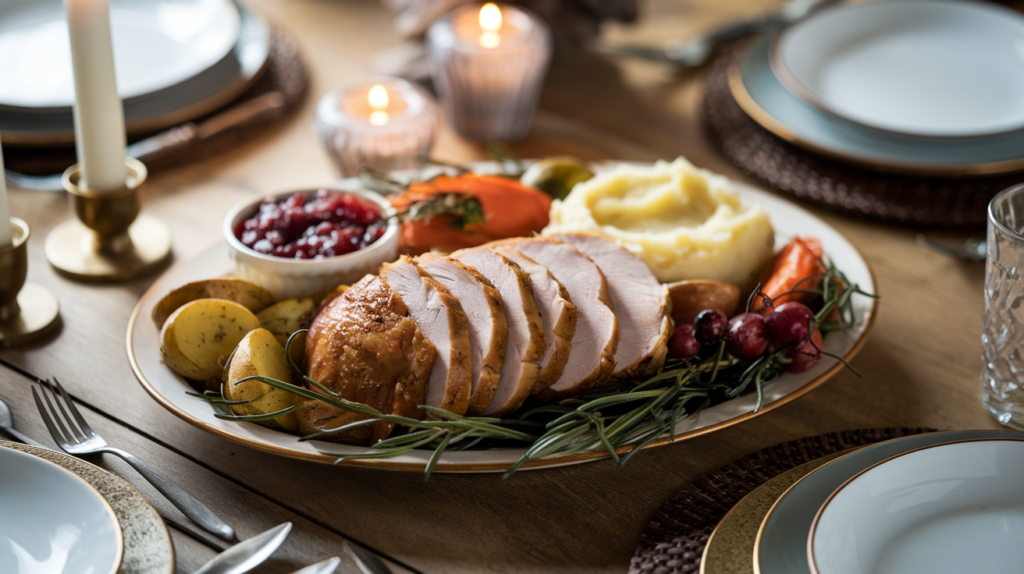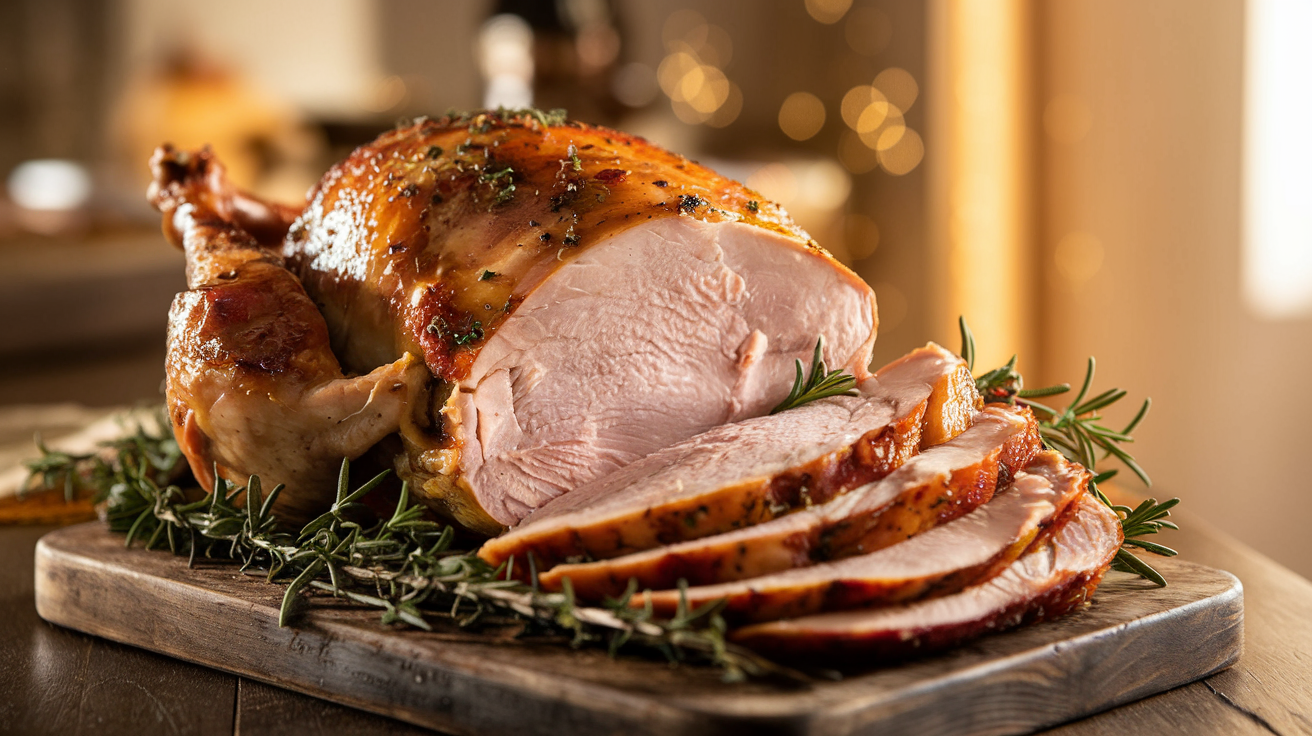Table of Contents
Smoking a turkey breast is a game-changer for anyone seeking bold flavor and tender, juicy meat. It’s an excellent alternative to a full bird, offering all the smokiness you love without the hassle of cooking an entire turkey. In this article, we’ll cover everything you need to know about making smoked turkey breast, from choosing the right cut to mastering smoking techniques. Along the way, we’ll discuss common mistakes, serving ideas, and even the health benefits of this delicious dish. Ready to up your smoking game? Let’s get started!
Introduction to Smoked Turkey Breast
Why Smoked Turkey Breast is a Favorite Choice
Smoked turkey breast is a top pick for anyone who loves smoky, rich flavors without spending hours prepping a full turkey. This cut is leaner, cooks faster, and is perfect for small gatherings or meal prep. The smoking process infuses the meat with a subtle depth that’s hard to achieve with traditional roasting.
Flavor and Texture of Smoked Turkey Breast
When done right, smoked turkey breast boasts a tender, juicy texture with just the right amount of smokiness. The outer layer develops a flavorful crust, thanks to a carefully applied rub, while the inside remains moist. The flavor profile can vary based on the wood chips you use—hickory adds boldness, while fruit woods like apple or cherry offer a mild sweetness.
Occasions Perfect for Smoked Turkey Breast
Whether it’s a holiday feast, a weekend barbecue, or just a craving for something hearty, smoked turkey breast fits the bill. It’s versatile enough for sandwiches, salads, or as the centerpiece of a dinner spread. Plus, its healthier profile makes it a guilt-free indulgence.
From casual cookouts to formal dinners, this dish is always a crowd-pleaser. Pair it with classic sides like mashed potatoes or coleslaw for a meal that satisfies every time.
Choosing the Right Turkey Breast for Smoking
Fresh vs. Frozen Turkey Breast: Which is Better?
When deciding between fresh and frozen turkey breast, consider convenience and quality. Fresh turkey breast offers optimal texture and flavor, but it has a shorter shelf life. Frozen turkey breast is a practical choice if you plan ahead. Thawing it properly ensures it’s just as juicy as fresh.
Pro Tip: If you’re short on time, opt for a fresh turkey breast. For planned events, frozen turkey breast is a cost-effective and flexible option.
Boneless or Bone-In: What Works Best for Smoking?
Choosing between boneless and bone-in turkey breast depends on your preference:
- Bone-In: Retains moisture and delivers a richer flavor due to the bones. It also cooks slower, giving more time for the smoky flavor to develop.
- Boneless: Easier to carve and serves well for sandwiches or meal prep.
If you’re smoking for a holiday meal or presentation, bone-in turkey breast often steals the show.
How to Select the Perfect Turkey Breast
Look for turkey breast that’s firm to the touch, has no off-putting smell, and has a smooth, unbroken surface. Organic and free-range options are also available for those prioritizing ethical and natural ingredients. Always check the weight to match your portion needs, as this affects smoking time.
Preparing the Turkey Breast for Smoking
Thawing and Cleaning the Turkey Breast
For frozen turkey breast, thaw it safely in the refrigerator 24–48 hours before smoking. If you’re in a pinch, use the cold water method, changing the water every 30 minutes. After thawing:
- Rinse the turkey breast under cold water.
- Pat it dry with paper towels to remove excess moisture.
Brining Basics for Juicy Smoked Turkey Breast
Brining is a game-changer for locking in moisture and flavor. Create a simple brine with water, salt, sugar, and aromatics like bay leaves, garlic, and peppercorns. Submerge the turkey breast in the brine for 6–12 hours.
For a quick solution, use a dry brine—simply rub salt and spices over the turkey and refrigerate it uncovered overnight.
Seasoning and Rubs: Bringing Out the Best Flavor
The right rub enhances the smoky flavor of the turkey breast. Here’s a classic rub recipe:
- Base Ingredients: Salt, black pepper, garlic powder, and paprika.
- Add a Twist: Include brown sugar for sweetness or chili powder for heat.
Rub the seasoning generously over the turkey, ensuring you get into every nook and cranny for maximum flavor.
Once seasoned, let the turkey rest for 30 minutes to absorb the flavors before placing it in the smoker. For more ideas on marinades and rubs, check out the Mexican Chicken Marinade Recipe for inspiration.
Let me know when you’re ready for Part 4: Step-by-Step Guide to Smoking Turkey Breast! 😊
Step-by-Step Guide to Smoking Turkey Breast

Choosing the Right Wood Chips for Smoking
The type of wood chips you use can dramatically influence the flavor of your smoked turkey breast. Here are some popular options:
- Applewood: Adds a subtle, fruity sweetness.
- Hickory: Creates a bold, rich smokiness that pairs well with the turkey’s natural flavor.
- Cherry: Gives a mild, slightly sweet aroma and a beautiful reddish hue to the meat.
If you’re a beginner, applewood is a great starting point for a balanced flavor profile.
Setting Up the Smoker: Temperature and Timing
Consistency is key when smoking turkey breast.
- Preheat the Smoker: Set your smoker to 225–250°F for a low-and-slow cooking process.
- Add Wood Chips: Place wood chips in the smoker box or directly onto the coals.
- Position the Turkey: Place the turkey breast skin-side up on the smoker rack.
Smoking Techniques: Low and Slow for Perfection
Patience is your best friend when smoking turkey breast.
- Smoke Time: It typically takes 3–4 hours to smoke a turkey breast, depending on its size. Plan for about 30–40 minutes per pound.
- Basting: Periodically baste the turkey breast with melted butter or broth to keep it moist and add flavor.
- Avoid Opening the Smoker: Each time you open the smoker, you lose heat and extend the cooking time.
Monitoring Internal Temperature for Safe Cooking
Use a meat thermometer to ensure your turkey breast is cooked to perfection:
- Target Temperature: The thickest part of the turkey breast should reach 165°F.
- Resting Temperature: Let the turkey breast rest for 10–15 minutes after removing it from the smoker. This helps redistribute the juices for a tender bite.
Resting and Slicing the Smoked Turkey Breast
Resting the turkey is crucial. Cover it loosely with foil and let it rest before slicing. Use a sharp knife to cut the turkey breast into even slices, ensuring each piece retains its moisture and flavor.
Serving Ideas and Side Dishes

Best Ways to Serve Smoked Turkey Breast
Smoked turkey breast is versatile, making it ideal for countless dishes:
- Main Course: Serve slices with mashed potatoes, gravy, and roasted vegetables for a classic dinner.
- Sandwiches: Use leftovers to make sandwiches with crusty bread, cranberry sauce, and a touch of Dijon mustard.
- Salads: Top a fresh green salad with thinly sliced turkey, nuts, and a tangy vinaigrette for a light, refreshing meal.
Top Side Dishes to Complement Smoked Turkey Breast
Pairing the right side dishes enhances the smoky flavor of the turkey:
- Creamy Mashed Potatoes: A comforting classic that balances the smokiness.
- Cornbread: Sweet and crumbly, it’s a great match for smoky meat.
- Coleslaw: Adds a refreshing crunch and tang to your plate.
- Grilled Vegetables: Zucchini, asparagus, and bell peppers pair beautifully with smoked flavors.
Common Mistakes to Avoid
Why Smoked Turkey Breast Can Turn Out Tough
One of the most common complaints about smoked turkey breast is a tough texture, which can ruin the eating experience. This usually happens when the meat is overcooked or cooked too quickly. High heat can dry out the lean turkey breast, leaving it chewy and unappetizing.
How to Avoid It:
- Stick to a low-and-slow cooking method at 225–250°F.
- Use a meat thermometer to ensure the internal temperature doesn’t exceed 165°F.
- Rest the turkey breast after cooking to let the juices redistribute.
Avoiding Over-Smoking and Maintaining Balance
Adding too many wood chips or over-smoking can overpower the delicate flavor of turkey breast, leaving it bitter. While smokiness is essential, balance is key.
How to Avoid It:
- Use a small handful of wood chips and replenish them sparingly.
- Pair mild woods like apple or cherry with a light rub to complement the meat’s flavor.
Proper Storage for Leftover Smoked Turkey Breast
Improper storage can lead to a loss of moisture and flavor in leftovers.
How to Store:
- Let the smoked turkey breast cool completely before wrapping it in foil or placing it in an airtight container.
- Store in the fridge for up to 4 days or freeze for up to 3 months.
For tips on reheating and repurposing leftovers, visit our site for additional poultry recipes and ideas.
FAQs About Smoked Turkey Breast
How Long Does It Take to Smoke a Turkey Breast?
Smoking a turkey breast takes approximately 3–4 hours, depending on its size and your smoker’s temperature. For optimal results, plan for 30–40 minutes per pound at a steady temperature of 225–250°F.
Is Smoked Turkey Breast Already Cooked?
This depends on the product. If you buy pre-packaged smoked turkey breast from the store, it’s usually fully cooked and just needs reheating. When smoking your own turkey breast, you must cook it thoroughly to an internal temperature of 165°F.
Are Smoked Turkey Breasts Healthy?
Yes! Smoked turkey breast is a lean source of protein and lower in fat compared to other smoked meats like brisket or ribs. It’s also rich in essential vitamins like B6 and B12. However, watch the sodium levels, especially if brined or store-bought.
Why Is My Smoked Turkey Breast Tough?
Toughness is typically caused by overcooking or not resting the meat after smoking. High heat dries out the lean turkey breast, while skipping the resting period means the juices won’t redistribute properly.
Nutritional Information and Health Benefits
Calorie and Protein Content of Smoked Turkey Breast
One of the reasons smoked turkey breast is so popular is its nutritional value. It’s packed with lean protein, which supports muscle growth and keeps you feeling full longer. On average, a 3-ounce serving of smoked turkey breast contains:
- Calories: 120–140
- Protein: 25–28 grams
- Fat: 2–3 grams
- Carbohydrates: 0 grams
This makes it a great choice for those following low-carb or high-protein diets.
Low-Fat and Low-Carb Benefits of Turkey Breast
Compared to other smoked meats like brisket or pork ribs, smoked turkey breast is significantly lower in fat and calories. Its naturally lean profile makes it a guilt-free option for health-conscious eaters. Additionally, it’s free from carbs, making it suitable for ketogenic and low-carb meal plans.
For the best results, avoid adding too much sugar to your rubs or brine, as this can increase the calorie count unnecessarily. With its high protein and low-fat content, smoked turkey breast is a fantastic choice for anyone looking to enjoy a flavorful yet healthy meal.
Conclusion and Final Thoughts
Why Smoked Turkey Breast is Worth the Effort
Smoking a turkey breast may take a bit of time and preparation, but the results are worth every minute. The smoky flavor, tender texture, and versatility of this dish make it a standout choice for everything from weeknight meals to special occasions. Plus, its health benefits add to its appeal, offering a lean and nutritious protein option that doesn’t compromise on taste.
Encouragement to Experiment with Techniques
Don’t be afraid to experiment with your smoked turkey breast recipe. Try different rubs, brines, and wood chips to create unique flavor profiles. Whether you’re a seasoned smoker or a beginner, each attempt will teach you something new and make your next batch even better.
